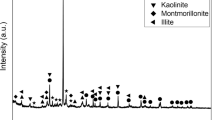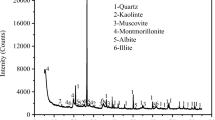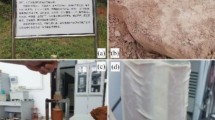Abstract
This work aims to investigate the influence of structural damage to natural soft clay on its mechanical behavior. K0 consolidated triaxial tests with loading and unloading stress paths were conducted, and field emission scanning electron microscopy (FESEM) and mercury intrusion porosimetry (MIP) were utilized for microstructural investigation. Macroscopic properties of soil were analyzed by microstructure evolution and damage theory. A pore size distribution index (S) was proposed that collectively accounts for the effect of pore size distribution and pore volume. Damage variables were determined based on the S to evaluate the damage degree of soft clay after K0 consolidation. The soil structure is obviously damaged when the confining pressure exceeds the preconsolidation pressure (119 kPa), with damage variables reaching 0.5 ~ 0.6 between 150 and 250 kPa. The initial tangent modulus and ultimate deviator stress of soft clay by reduced triaxial compression (RTC) tests are lower than those by conventional triaxial compression (CTC) tests. It is associated with relatively different microstructure failure modes, i.e., a loose uniform failure mode for RTC specimens and a locally dense non-uniform failure mode for CTC ones. However, the natural structure is slightly damaged after consolidation, and marginal macro and micro differences were observed between CTC and RTC test results when the confining pressure is less than the preconsolidation pressure. Therefore, the mechanical behavior of soft clay is strongly affected by stress paths and damage to the natural structure during consolidation and shearing processes on the macroscopic and microscopic views.

















Similar content being viewed by others
Data availability
All data, models, and code generated or used during the study appear in the submitted article.
References
Akbarimehr D, Eslami A, Aflaki E, Imam R (2020) Using empirical correlations and artificial neural network to estimate compressibility of low plasticity clays. Arabian J Geosci 13:1–11. https://doi.org/10.1007/s12517-020-06228-3
Akbarimehr D, Eslami A, Imam R (2021) Correlations between compression index and index properties of undisturbed and disturbed Tehran clay. Geotech Geol Eng 39(7):5387–5393. https://doi.org/10.1007/s10706-021-01821-z
Bian S, Mi Z, Li G, Ai Y, Du G (2022) Unified modeling behavior of rockfill materials along different loading stress paths. Soils Found 62(3):101155. https://doi.org/10.1016/j.sandf.2022.101155
Cai YQ, Hao BB, Gu C, Wang J, Pan LY (2018) Effect of anisotropic consolidation stress paths on the undrained shear behavior of reconstituted Wenzhou clay. Eng Geol 242:23–33. https://doi.org/10.1016/j.enggeo.2018.05.016
Cui ZD, Yang JQ, Yuan L (2015) Land subsidence caused by the interaction of highrise buildings in soft soil areas. Nat Hazard 79:1199–1217. https://doi.org/10.1007/s11069-015-1902-8
Delage P (2010) A microstructure approach to the sensitivity and compressibility of some Eastern Canada sensitive clays. Géotechnique 60(5):353–368. https://doi.org/10.1680/geot.2010.60.5.353
Du JP, Zhou AN, Shen SL, Bu YH (2022) Fractalbased model for maximum penetration distance of grout slurry flowing through soils with different dry densities. Comput Geotech 141:104526. https://doi.org/10.1016/j.compgeo.2021.104526
Eslami A, Akbarimehr D (2021) Failure analysis of clay soilrubber waste mixture as a sustainable construction material. Constr Build Mater 310:125274. https://doi.org/10.1016/j.conbuildmat.2021.125274
Gao QF, Hattab M, Jrad M, Fleureau JM, Hicher PY (2020) Microstructural organization of remoulded clays in relation with dilatancy/contractancy phenomena. Acta Geotech 15:223–243. https://doi.org/10.1007/s11440-019-00876-w
Gasparre A, Coop MR (2008) Quantification of the effects of structure on the compression of a stiff clay. Can Geotech J 45(9):1324–1334. https://doi.org/10.1139/t08-052
Gasparre A, Nishimura S, Coop MR, Jardine RJ (2011) The influence of structure on the behaviour of London Clay. Stiff Sedimentary Clays: Genesis and Engineering Behaviour: Géotechnique Symposium in Print 2007. Thomas Telford Ltd. pp 67–79 https://doi.org/10.1680/ssc.41080.0007
GB, T 50123–2019 (2019) Standard for soil test method. China Planning Press, Beijing (in Chinese)
Guglielmi S, Cotecchia F, Cafaro F, Gens A (2022) Analysis of the micro to macro response of clays to compression. Géotechnique 1–21. https://doi.org/10.1680/jgeot.21.00233
He YQ, Wang S, Liao HJ, Wu W (2022) A hypoplastic constitutive model for structured soils. Comput Geotech 151:104935. https://doi.org/10.1016/j.compgeo.2022.104935
Jiang MJ, Hu HJ, Peng JB, Leroueil S (2011) Experimental study of two saturated natural soils and their saturated remoulded soils under three consolidated undrained stress paths. Front Archit Civ Eng China 5:225–238. https://doi.org/10.1007/s11709-011-0108-8
Jiang MJ, Zhang FG, Hu HJ, Cui YJ, Peng JB (2014) Structural characterization of natural loess and remolded loess under triaxial tests. Eng Geol 181:249–260. https://doi.org/10.1016/j.enggeo.2014.07.021
Kantesaria N, Sachan A (2022) Smallstrain shear modulus and yielding characteristics of compacted highplasticity clay. Géotechnique 72(5):424–437. https://doi.org/10.1680/jgeot.20.p.089
Kondner RL (1963) Hyperbolic stress-strain response: cohesive soils. J Geotech Geoenviron Eng 89(1):115–143. https://doi.org/10.1061/jsfeaq.0000479
Korvin G (1992) Fractal models in the earth sciences. Elsevier, Amsterdam
Lei XY (1988) The types of loess pores in China and their relationship with collapsibility. Sci Sin Ser B Chem Biol Agric Med Earth Sci 31(11):1398–1410. https://doi.org/10.1111/j.1755-6724.1989.mp2004008.x
Lei HY, Liu M, Jiang Y, Sun XF (2020) Deformation of Tianjin soft clay and corresponding micromechanism under cyclic loading. Can Geotech J 57(12):1893–1902. https://doi.org/10.1139/cgj-2019-0352
Li J, Tang YQ, Feng W (2020a) Creep behavior of soft clay subjected to artificial freeze–thaw from multiplescale perspectives. Acta Geotech 15:2849–2864. https://doi.org/10.1007/s11440-020-00980-2
Li P, Shao SJ, Vanapalli SK (2020b) Characterizing and modeling the poresize distribution evolution of a compacted loess during consolidation and shearing. J Soils Sediments 20:2855–2867. https://doi.org/10.1007/s11368-020-02621-3
Li P, Shao SJ, Xiao T, Zhu DD (2021) Poresize distribution evolution of intact, compacted, and saturated loess from China during consolidation and shearing. Adv Civ Eng 1–14. https://doi.org/10.1155/2021/6644471
Liu HB, Sun S, Wang LX, Zhang YL, Wang J, Luo GB, Han LL (2020) Microscopic mechanism of the macroscopic mechanical properties of cement modified subgrade Silty soil subjected to freezethaw cycles. Appl Sci 10(6):2182. https://doi.org/10.3390/app10062182
Liu WH, Zhang HY, Li WG, Kong GQ, Lin XY (2022) An advanced critical state constitutive model for overconsolidated structured soils. Int J Geomech 22(5):06022004. https://doi.org/10.1061/(asce)gm.1943-5622.0002349
Low HE, Phoon KK (2008) Effect of cementation on the compressibility of Singapore upper marine clay. Can Geotech J 45(7):1018–1024. https://doi.org/10.1139/t08-030
Ma PF, Wang WX, Zhang BW, Wang JL, Shi GS, Huang GQ, Chen FL, Jiang LM, Lin H (2019) Remotely sensing largeand smallscale ground subsidence: a case study of the Guangdong-Hong Kong–Macao Greater Bay Area of China. Remote Sens Environ 232:111282. https://doi.org/10.1016/j.rse.2019.111282
Musso G, Azizi A, Jommi C (2020) A microstructure-based elastoplastic model to describe the behaviour of a compacted clayey silt in isotropic and triaxial compression. Can Geotech J 57:1025–1043. https://doi.org/10.1139/cgj-2019-0176
Nan JJ, Peng JB, Zhu FJ, Ma PH, Liu R, Leng YQ, Meng ZJ (2021) Shear behavior and microstructural variation in loess from the Yan’an area. China. Eng Geol 280:105964. https://doi.org/10.1016/j.enggeo.2020.105964
Ng CWW, Akinniyi DB, Zhou C (2020) Influence of structure on the compression and shear behaviour of a saturated lateritic clay. Acta Geotech 15:3433–3441. https://doi.org/10.1007/s11440-020-00981-1
Ovando Shelley E, Rodríguez Rebolledo JF, ValderramaAtayupanqui YV (2020) Geotechnical characteristics of natural and reconstituted lacustrine Mexico City clays. Geotech Geol Eng 38:1471–1484. https://doi.org/10.1007/s10706-019-01103-9
Qiao YS, Liu JG, Cao L, Khan MHR, Xu XD, Tan L (2021) Contribution of continuously stable sediment input to the formation of the Pearl River delta since the middle Holocene. Quat Int 598:7889. https://doi.org/10.1016/j.quaint.2021.05.010
Ren YB, Yang SL, Zhang SX, Yang Q, Wang Y, He B, Huan CY (2022) Experimental study of the thixotropic strength recovery and microstructural evolution of marine clays. J Geotech Geoenviron Eng 148(8):04022059. https://doi.org/10.1061/(asce)gt.1943-5606.0002833
Romero E, Simms PH (2008) Microstructure investigation in unsaturated soils: a review with special attention to contribution of mercury intrusion porosimetry and environmental scanning electron microscopy. Geotech Geol Eng 26:705–727. https://doi.org/10.1007/978-1-4020-8819-3_8
Su SQ, Deng BT, Hou JF, Lv Z (2012) Experimental study on shear strength of intact loess at different stress paths. Advanced Materials Research. Trans Tech Publ, pp 2891–2894
Sun H, Mašín D, Najser J, Neděla V, Navrátilová E (2020) Fractal characteristics of pore structure of compacted bentonite studied by ESEM and MIP methods. Acta Geotech 15:1655–1671. https://doi.org/10.1007/s11440-019-00857-z
Tan Y, Jiang WZ, Rui HS, Lu Y, Wang DL (2020) Forensic geotechnical analyses on the 2009 buildingoverturning accident in Shanghai, China: beyond common recognitions. J Geotech Geoenviron Eng 146(7):05020005. https://doi.org/10.1061/(asce)gt.1943-5606.0002264
Wang YH, Xu D (2007) Dual porosity and secondary consolidation. J Geotech Geoenviron Eng 133(7):793–801. https://doi.org/10.1061/(asce)1090-0241(2007)133:7(793)
Wang JD, Li P, Ma Y, Vanapalli SK, Wang XG (2020) Change in poresize distribution of collapsible loess due to loading and inundating. Acta Geotech 15:1081–1094. https://doi.org/10.1007/s11440-019-00815-9
Wang HL, Sun H, Huang ZX, Ge XR (2021a) A microstructural investigation on hydraulic conductivity of soft clay. Bull Eng Geol Environ 80:4067–4078. https://doi.org/10.1007/s10064-021-02176-8
Wang Y, Yang H, Jing X (2021b) Structural characteristics of natural loess in Northwest China and its effect on shear behavior. Geotech Geol Eng 39:65–78. https://doi.org/10.1007/s10706-020-01420-4
Washburn EW (1921) The dynamics of capillary flow. Phys Rev 17(3):273–283. https://doi.org/10.1103/PhysRev.17.273
Xu L, Coop MR (2016) Influence of structure on the behavior of a saturated clayey loess. Can Geotech J 53(6):1026–1037. https://doi.org/10.1139/cgj-2015-0200
Yin PH, Vanapalli SK (2022) Model for predicting evolution of microstructural void ratio in compacted clayey soils. Can Geotech J 59(9):1602–1621. https://doi.org/10.1139/cgj-2021-0057
Zeng LL, Ji F, Wang H, Cai YQ, Hong ZS (2022) Estimating hydraulic conductivity of naturally sedimented clays using compression curves. Acta Geotech 17:1815–1827. https://doi.org/10.1007/s11440-021-01306-6
Zhang YZ, Zuo SY, Li RYM, Mo YC, Yang GS, Zhang M (2020) Experimental study on the mechanical properties of Guiyang red clay considering the meso micro damage mechanism and stress path. Sci Rep 10(1):17449. https://doi.org/10.1038/s41598-020-72465-x
Zhang XW, Liu XY, Xu YQ, Wang G, Ren YB (2023) Compressibility, permeability and microstructure of finegrained soils containing diatom microfossils. Géotechnique 1–15. https://doi.org/10.1680/jgeot.22.00155
Zheng YM, Sun H, Hou MX, Ge XR (2021) Microstructure evolution of soft clay under consolidation loading. Eng Geol 293:106284. https://doi.org/10.1016/j.enggeo.2021.106284
Zheng Y, Baudet BA, Delage P, Pereira JM, Sammonds P (2022) Pore changes in an illitic clay during one-dimensional compression. Géotechnique 1–16. https://doi.org/10.1680/jgeot.21.00206
Zhou ZW, Ma W, Zhang SJ, Mu YH, Li GY (2020) Experimental investigation of the pathdependent strength and deformation behaviours of frozen loess. Eng Geol 265:105449. https://doi.org/10.1016/j.enggeo.2019.105449
Funding
This work was supported by the National Natural Science Foundation of China (No. 41572255) and the Guangdong Provincial Key Laboratory of Modern Civil Engineering Technology (No. 2021B1212040003).
Author information
Authors and Affiliations
Corresponding author
Ethics declarations
Conflict of interest
The authors declare no competing interests.
Rights and permissions
Springer Nature or its licensor (e.g. a society or other partner) holds exclusive rights to this article under a publishing agreement with the author(s) or other rightsholder(s); author self-archiving of the accepted manuscript version of this article is solely governed by the terms of such publishing agreement and applicable law.
About this article
Cite this article
Liang, Z., Sun, H., Huang, Z. et al. The influences of natural structure damage and stress path on mechanical behaviors of soft clay. Bull Eng Geol Environ 82, 208 (2023). https://doi.org/10.1007/s10064-023-03237-w
Received:
Accepted:
Published:
DOI: https://doi.org/10.1007/s10064-023-03237-w




